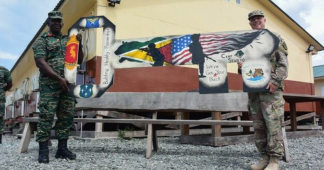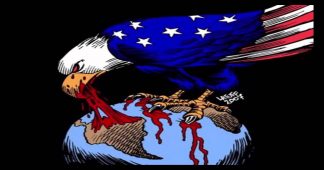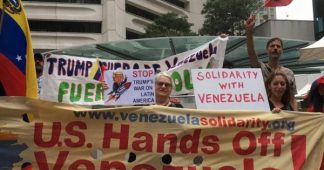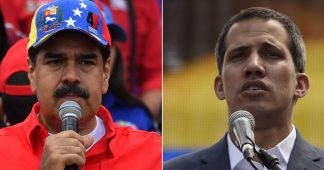February 3, 2021
Why is Canada pushing Guyana, an impoverished nation of 800,000, into conflict with Venezuela while helping multinationals grab its oil?
Recently Canadian officials criticized Venezuela’s position regarding its territorial dispute with Guyana, which sits on the northeastern tip of South America. Soon after the US put out a statement on the century-old dispute, the Canadian High Commission declared “Venezuela’s recent claim that it has sovereignty over the area adjacent to Guyana’s Essequibo coast is concerning. The decision is in the hands of the International Court of Justice and this judicial process must be respected.”
The Canadian and US statements were in response to Caracas criticizing an International Court of Justice ruling and a joint US/Guyana coast guard exercise in disputed waters that took place on January 8. After that patrol Commander of the US Southern Command Admiral Craig Faller, spent three days in the former British colony. During Faller’s visit the two countries signed a bilateral defence cooperation agreement. The deepening military ties follow on the heels of the first-ever visit by a US secretary of state. In September Mike Pompeo met new Guyanese President Mohamed Irfaan Ali, who Washington backed during an election dispute that paralyzed the country politically for months.
Ottawa also intervened aggressively in the controversial election. Canadian officials released multiple statements critical of the previous government and the vote counting. Apparently, Guyana’s new government is more willing to lend itself to the US-led campaign against Venezuela and to foreign oil interests at the centre of the resurgent territorial dispute.
Washington was once on the other side of the territorial dispute that nearly led the US to invade Canada. At the end of the 1800s British encroachment into what Venezuela considered its territory prompted Washington to assert the Monroe Doctrine, which granted it the “right” to intervene in the internal affairs of countries in the hemisphere. As conflict between Washington and London escalated, Canadian officials worried that war would lead to a US invasion.
Ultimately the dispute was resolved through international arbitration. It was disastrous for Venezuela. Washington legitimated its interventionist Monroe Doctrine and Venezuela lost 90% of the territory. London made a deal with the deciding Russian officials to support its claim. When the underhanded nature of the deal came to light decades later Venezuela renewed its claim to the disputed territory.
In recent years the territorial dispute has been rekindled due to the discovery of large amounts of oil in the sparsely populated region. Prior to Exxon-Mobil’s discovery the Venezuelan government called on the US company to stop drilling. In 2015 Caracas also sent a cease-and-desist letter to Toronto-based Guyana Goldfields, which operated a large gold mine in the disputed area.
While the Guyanese are largely united regarding the territorial dispute, the oil discovery has been quite controversial. There are concerns over the impact of pollutants on communities and fisheries as well as oil spills, which the government will pay to clean up according to its agreement with Exxon. Many in the climate-vulnerable coastal nation are also troubled by the greenhouse gas emissions that will be released. There is also criticism of highly preferential royalty rates. In February Global Witness reported that Exxon and other firms’ sweetheart deal deprived Guyana of billions of dollars in potential revenue. The report, “shows how the oil major used aggressive tactics and threats to pressure inexperienced Guyanese officials to sign the deal for the Stabroek license.”
Amidst significant political backlash, former Alberta Premier Alison Redford was appointed in August to lead a review of Exxon Mobil’s massive planned Payara offshore oil field. Redford’s ties to Exxon should have made her appointment controversial. Exxon-Mobil’s 60% Canadian owned subsidiary, Imperial Oil of Canada, is highly influential in the province she once lead. During Redford’s time as a minister and premier of Alberta Exxon’s subsidiary contributed an average of $10,000 a year to her Conservative party.
Redford’s appointment was also controversial since Ottawa “identified her” to Guyana’s new government and funded the process. Canada’s High Commission paid for Redford and other Canadian consultants to review Exxon’s proposal.
On October 1 researcher Bob Thomson put in an Access to Information request for “a copy of the contract between the High Commission and/or Global Affairs and Ms. Redford and/or the company she represents and any terms of reference related to that contract”, as well as “copies of any correspondence between the Canadian High Commission, Global Affairs and the Government of Guyana related to Canadian expectations, interests or benefits from Canadian taxpayer funding of this review.” Despite the law giving the government 30 days to respond (and a possible 30-day extension), the access request has yet to be fulfilled.
The Canadian government openly promotes oil interests in Guyana. They recently announced that their Trade Commissioner Service “laid the groundwork for approximately 20 partnerships between Canadian and Guyanese private sector organizations in the oil and gas sector.” In a December story headlined “How Guyana is emerging as the new frontier for N.L.’s oil services sector”, CBC described a “swarm of companies from the Newfoundland and Labrador oil services sector that is making a play for business in Guyana.” One hundred and seventy firms participated in a virtual Guyanese trade mission organized by Newfoundland’s oil industry association and the High Commission facilitated a capacity accord between Guyana and Newfoundland’s Ministry of Natural Resources. Toronto-based Cataleya holds a 25% stake in another Exxon-led project adjacent to Stabroek with the rights to drill in a 3.3 million-acre area.
Last month outgoing High Commissioner Lilian Chatterjee urged Guyanans: “Don’t resist foreign investment but use your judgement on who you can trust.” Unsurprisingly, Chatterjee told the audience that the Canadian government and corporations were to be “trusted”. Canada was more trustworthy, she said, because “we were here when you had no oil. We have been a strong and reliable friend for more than a century and we have supported your development all along the way.”
As I detail here, Ottawa tried to annex British Guyana in the early 1900s and Canadian troops were deployed there during World War II. Traditionally, the leading powers in Guyana have demonstrated considerable trust in Canada. In the 1950s the British spy agency MI6 asked Ottawa to place a “special economic adviser” in leftist Prime Minister Cheddi Jagan’s government to monitor and influence policy. When he returned to power a decade later — the British ousted him in 1954 — the CIA sought Canadian support to strengthen labour opposition to Jagan. A US cable explained, “it might be good idea if U.S. union movement could find Canadian to send in to” stoke antigovernment agitation. (Previously Canadian Congress of Labour executive member Charles Millard argued that aid to Guyana was “in the interests of Canadian security”, partly because it would undercut Jagan’s bid to nationalize the Alcan dominated bauxite industry, which would be “detrimental to Canadian interests.”)
So, not much seems to have changed over the decades. Despite claiming to be a ‘force for good’ in the world, Ottawa is helping wealthy and powerful corporations grab Guyana’s oil and is pushing the country into conflict with Venezuela as part of a push to destabilize an enemy of Washington. Maybe this time though unions and other social activists will try to stop, rather than cheer on, Canada’s imperialist behaviour.
Published at www.counterpunch.org











